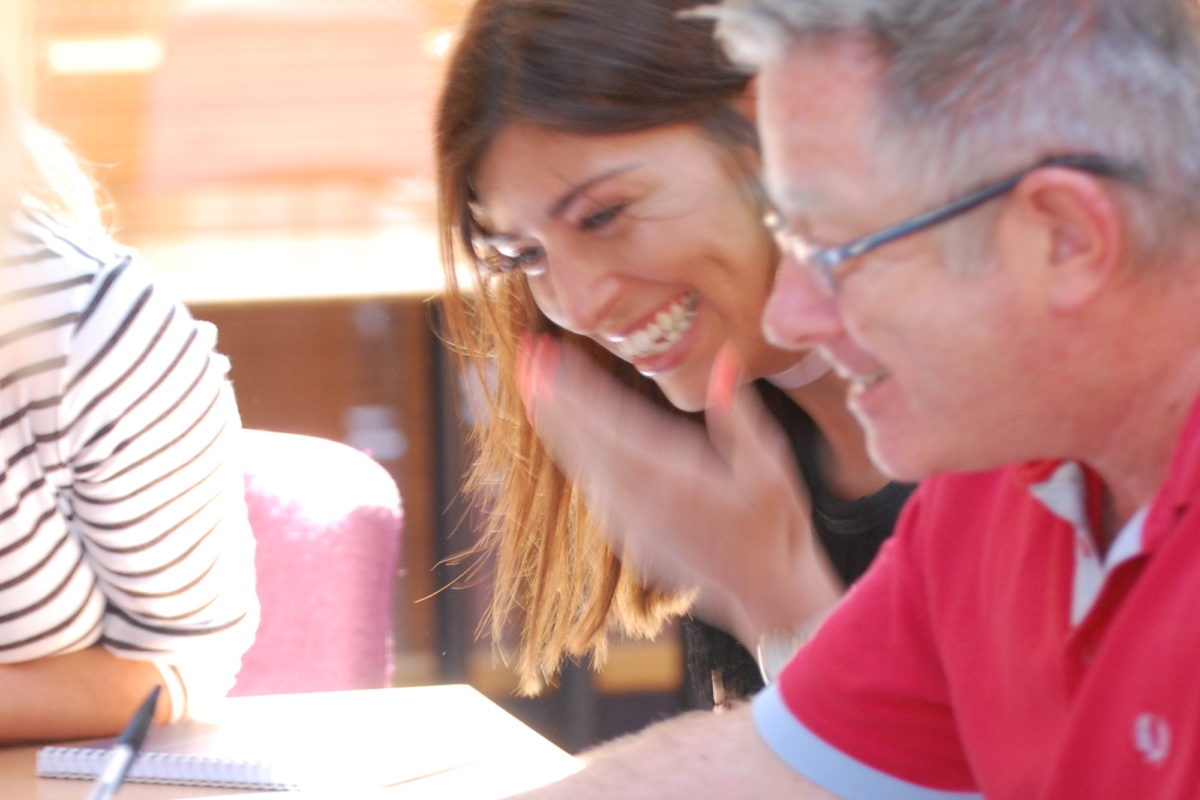
About September
In a world of work that is increasingly complex, volatile, uncertain and ambiguous, people need to be able to adapt quickly and positively, and be resilient to all types of pressures. To thrive in this world, organisations will need to focus on more than employee engagement… they will need to enable and empower wellbeing.
Maintaining and improving your psychological wellbeing (positive emotions, relationships, time in flow, meaning, achievement etc.) is consistently It goes beyond employee engagement for these 3 reasons:
· It addresses the whole person – It realises that in order to perform at your best, you need to bring your whole, authentic self to work.
· It encourages people to use their unique strengths, even if these are outside the traditional scope of role, so that they can be at their best every day
· It is for everyone – It realises that people no longer work in siloed teams, and that engagement and wellbeing should not be measured and discussed in this way.
· It benefits work & beyond – It recognises that the experiences people have at work impacts their whole life. It raises topics that will benefit people in all aspects of their life, and that they will carry forward with them in the future.
We challenge you to push further than employee engagement, to start the conversation on what matters most to people at work, on wellbeing. As People Teams and HR Functions, our job shouldn’t be about policing completion of surveys and coming up with all the solutions. We need to give people the platforms and tools to discuss and act on the things that matter most to them, and continue to empower people to take responsibility for being their best each and every day.
We do this through self-facilitating conversation mats that any group of people can use at any time. They table topics that are often taboo, and put responsibility for quick-wins and longer-term actions in the hands of each individual.
We will be talking about this topic much more at the Wellbeing @ Work Conference in London on November 1st. We look forward to seeing you there!

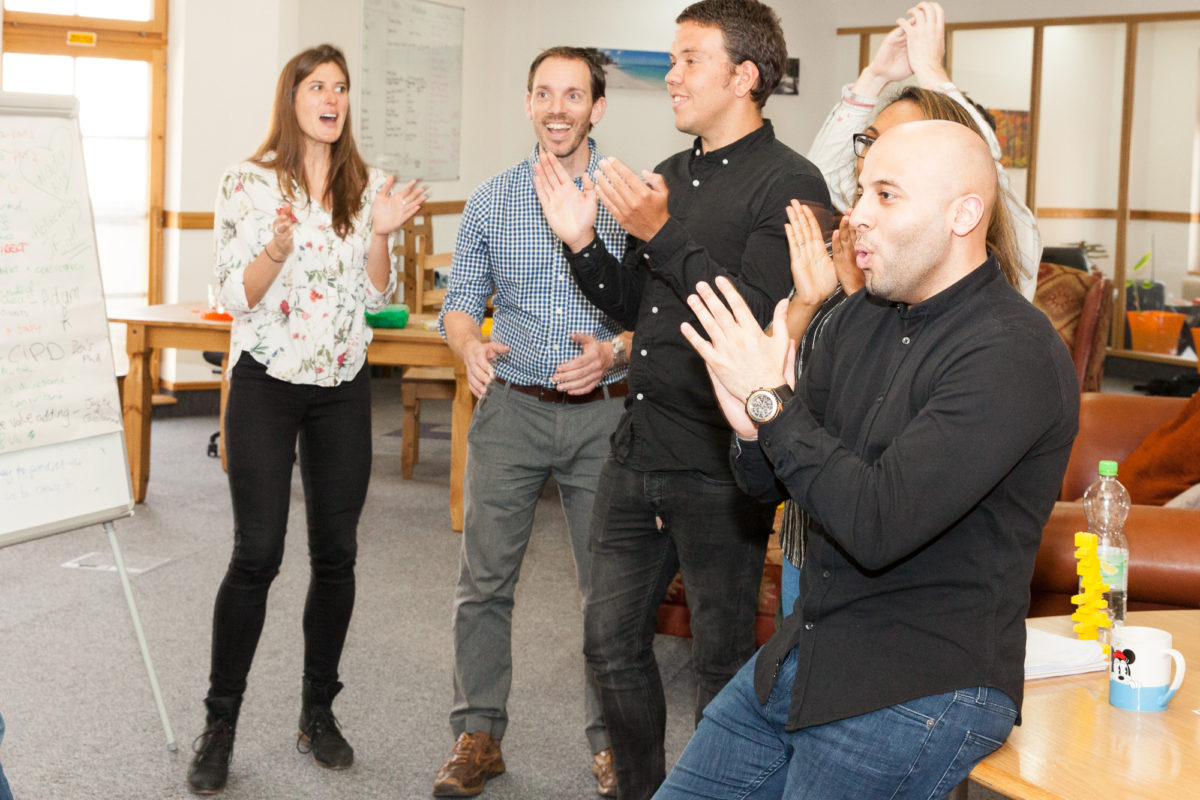
About Are
Are you addicted to work? Another reason to increase personal accountability for wellbeing at work.
Over the past ten years the focus on employee engagement and improved leadership has meant thankfully many more people are genuinely in roles that play to their strengths, give meaning and purpose, support positive relationships and that ultimately they enjoy.
Me included. I really do love what I do, I use my strengths every single day and get an amazing sense of fulfilment from my work. I constantly have to juggle this love for my work with my other life demands of being a full time working mum to my little ones, remember to feed the increasing menagerie of animals, not forget my family celebrations and tending to my important friendships as well as trying to be a great wife. But I have to admit I get such a rich sense of thriving and flourishing in my work that often I have to reign myself in.
I know I’m not the only one. I often hear people say to me jokingly “it’s easier to be at work” and it resonates. Chatting with other parents this week at the school gates hearing people say how much work they’ve got done now kids are back at school with a big smile on their face. It’s an environment I know, I can influence and can achieve and feel productive and capable, top of my game. I don’t have a nanny, house husband or able parents to support my constant juggling and when one of life’s big challenges comes my way it’s harder than hard to get through it, but we do. And often it’s work that helps me, something constant, something meaningful, supportive work relationships, but above all for me it’s the achievement of moving things forward. I expect it’s something different for everyone depending on what they enjoy most in their work.
The balance to ensure that I am indeed still focusing on other key areas of my life is my responsibility, not anyone else’s. I have my own reminders on my desk, pictures of my kids and their latest masterpieces, yet I still regularly find myself sprinting out of the door to go pick them up on time because I’ve been completely absorbed in another fascinating piece of work. I’ve allowed myself to be completely absorbed even though I’m fully aware that I should be packing up to go.
There is always more work. It will never be finished. At school our kids are constantly taught to stretch and grow in their learning and this is the same in modern L&D approaches in organisations. Everything is a journey full of opportunities and possibilities so it is only us, ourselves, who can determine where we draw the line.
I hear people go on about the hours they do as if it’s always someone else’s fault, yet I know lots of people love being busy, needed, included, required in back to back meetings, it boosts how important people feel about themselves even if it means they are still working late and other parts of their life suffer. It can tip over the edge and have a huge influence on our identity. I also know that our increase in work/life integration is not a bad thing for everyone – I know my crazy working hours allow me to be the best mum I can be by swapping daytime hours for night time or weekend working. And now LinkedIn has a green dot on those online I can see lots of people are indeed working different hours because they choose to also.
So increasing people’s knowledge of what positive wellbeing is, guiding learning of skills to equip us and giving confidence in ourselves to know how and when to balance our life priorities is key. We are only going to be more empowered in work in the future so equipping people to lead themselves effectively and take care of their wellbeing at work is fundamental as a preventative approach for all people in organisations in addition to and alongside the more targeted interventions for those struggling at a crisis point.
Alex Bailey
For more information on our wellbeing programmes, including our wellbeing conversation mat, workshops and notebooks, email us or call +44 1273 830 830. To purchase the wellbeing conversation mats and notebooks directly via our online shop click here.

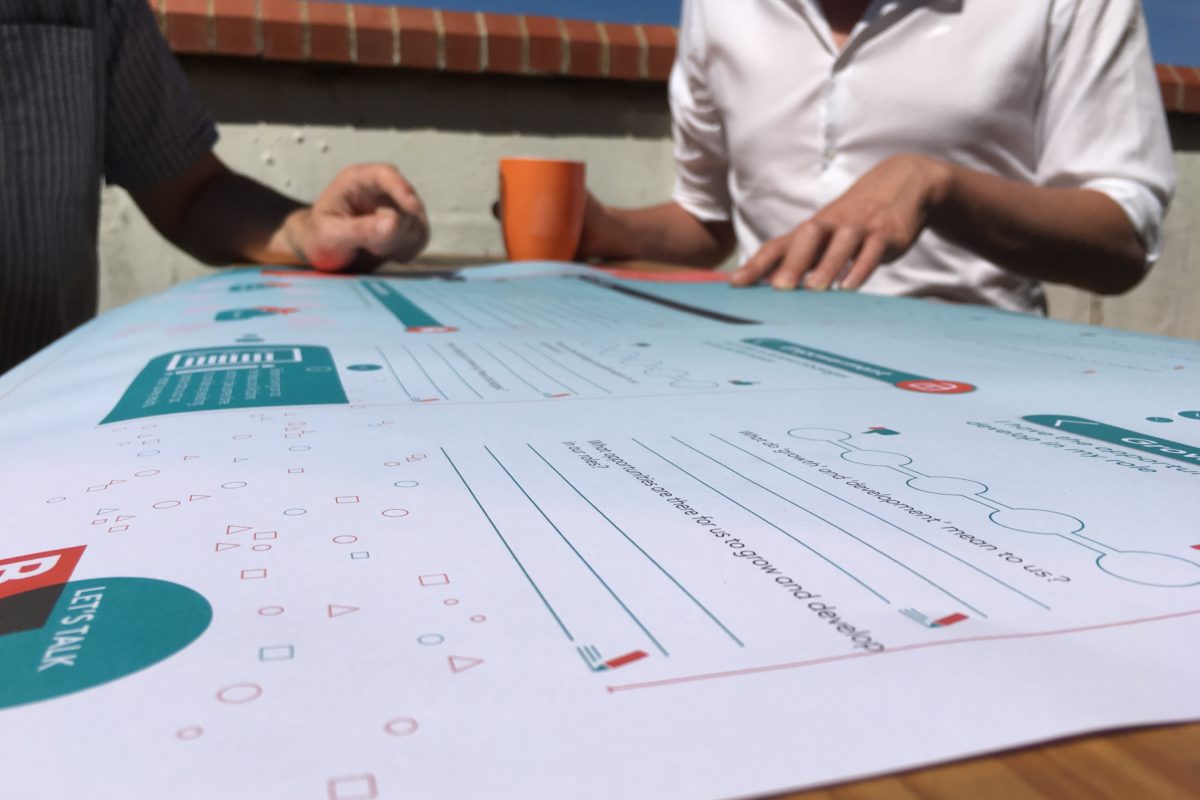
About August
Imagine a world where people understand what really impacts their wellbeing and have the knowledge, tools and habits in place to be at their best every day. We are striving for this vision, and believe we have designed a way to help organisations start the conversation, promote personal accountability and create a true culture of wellbeing.
Start the conversation.
Using our simple A1 Wellbeing Conversation Mat, start the conversation and gain a ‘pulse-check’ of current levels of wellbeing across people, teams and whole organisations. Simple and easy, a session can be run as a lunchtime activity or form part of an away day with teams.
Give people skills.
We run a series of six in-person or virtual wellbeing workshops to help people learn how to practically improve their wellbeing. They’re interactive and fun – encouraging peer-to-peer learning and exploration, and making wellbeing easy for everyone to understand and apply on both an individual and organisational level.
Make it everyday.
Our Wellbeing Notebooks support people to build their self-awareness and individual learning. They’re packed with activities, reflection questions and practical tasks, designed to keep wellbeing front of mind every day.
We will be talking about this and so much more at the Wellbeing @ Work Conference in London on November 1st. We look forward to seeing you there!




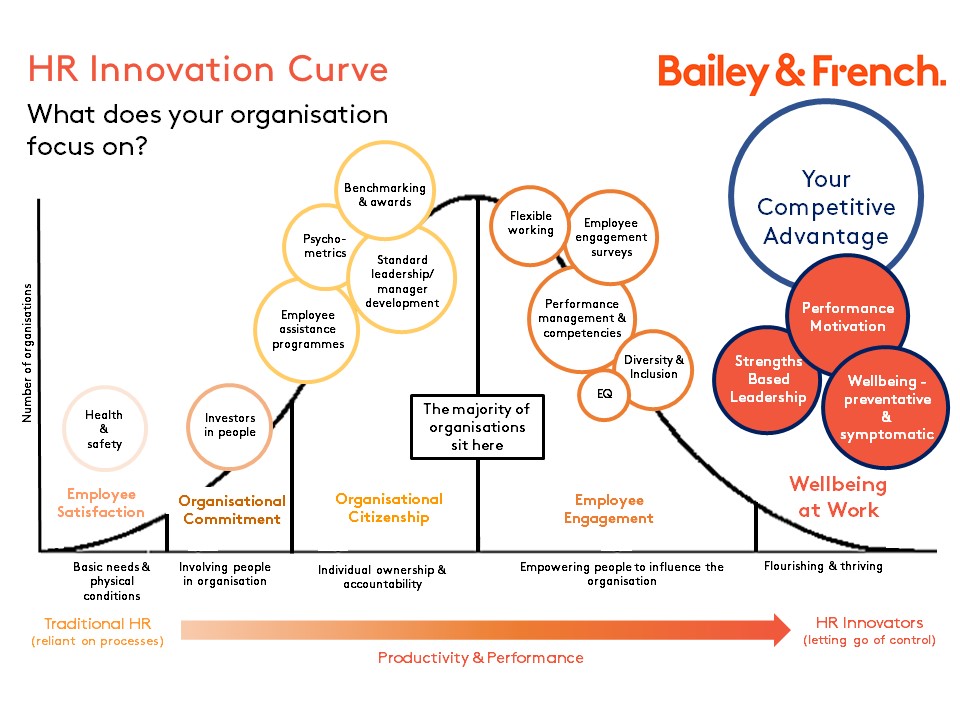
About How
Employee satisfaction used to be enough. As long as the working environment was safe and pay was fair, what more could a ‘worker’ expect? HR in those times could afford to be fully reliant on process. Innovation wasn’t necessary.
For a while we’ve been developing this HR Innovation Curve, designed to show exactly where we need to be focusing our attention if we want to be our best, most innovative selves and build the best organisations we can. It also tells the story of this evolution of needs.
As we know, things evolve. Over the last couple of decades, the needs and expectations of people have been rapidly ascending Maslow’s pyramid and this has meant that HR teams have had to continually up their game
In the early 2000s, we moved beyond employee satisfaction and organisational commitment to try to build a sense of citizenship. Investment was high, we saw more HRDs on organisational boards, and the ‘war for talent’ was big news, with pioneering HR programmes attracting, developing and retaining great people to maintain competitive advantage.
Next, the psychometric market exploded, with a raft of different tests claiming to be the best way to understand ourselves and others better. This was supported by leadership development budgets for those deemed to be ‘Top Talent’ (decided by nine-box grids or bell curves), and Employee Assistance Programmes for those dealing with less competent managers and working practices. Strategically making the most of all this development, the awards market cranked into life, full of organisations applying (and paying) to be benchmarked against those in totally different markets/industries and sectors.
Before very long, citizenship wasn’t enough. High employee engagement was vital for organisations to maintain their competitive edge, and the surveys to measure this seemed to became mandatory (see here for my views around the survey approach). HR teams were working hard to tap into the ‘discretionary effort’ that engaged people give to their work with fabulous impact on performance and the bottom line. But this led to a huge industry in EE and incredible amounts of champion teams actioning all the levers to influence how everyone feels at work. When we realised clarity was a lever for engagement, we created heavy process-driven performance management and appraisal systems, kicking off the need for data analysis to ensure this mass of people info was being used impactfully. At the same time came the focus on competencies, with some frameworks stacking up to over 300 competencies, which people were rated against.
And now, here we are acting as if the big hot potato ‘wellbeing’ is another initiative to build engagement. It’s not. It’s everything we have done so far and more. It’s about going beyond simply empowering people to influence their organisations to supporting them to thrive and flourish at work and beyond. It means we have to step up and do more. Much more. Not just recommunicate the EAP we introduced ten years ago and remind everyone what it’s for. Not just help people recognise and deal with the symptoms of negative workplaces creating mental ill health. Not just offer gym memberships, yoga or healthy snacks for people to feel better despite the major causes of workplace stress being ignored.
We need authentic, positively-focused leaders who know how to empower their teams and can tap into intrinsic motivators and harness their collective intelligence.
We need a culture where people actually want to have conversations around performance, because the focus is on developing our strengths, and supporting us to be self-actualised at work and beyond.
We need a deeper understanding of what latest research tells us really truly impacts positive wellbeing – Positive Emotions, Engagement, Positive Relationships, Meaning and Achievement – and we need to support people to develop the skills to keep strengthening their own and others’ wellbeing in the future.
This increasingly digital world is going to challenge us in innovating beyond tech, innovating as humans and not losing the human feel and connection through to the unknown of the future.
We continually review our past and present in order to best enter our future (Seligman et al., 2016). So we should be doing so now in HR in how we have supported people and organisations over time to ensure we best enter our future and shape it.
Click here to read our article that explains our approach to supporting wellbeing in organisations, and contact us now to find out how we help people build better organisations. We have programmes for Wellbeing, Strengths Based Leadership and Performance Motivation and would love to chat.
References
M. E. P. Seligman, P. Railam, R. F Baumeister and C. Sripada (2016). Homo Prospectus. London: Oxford University Press.
Alex Bailey

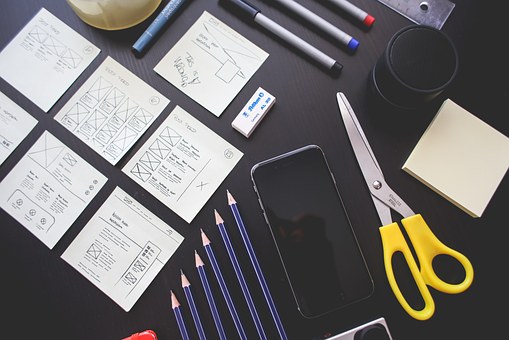
About Three
Developing organisational wellbeing can feel like a big task. We know it’s something we should be doing, but often don’t have the first idea what to do, what will make a real difference, and what will be a waste of our shiny new budget (and result in us not getting it again next year).
Here are three easy, practical and scalable things we can do:
1. talk about it
Our Wellbeing Conversation Mat is a great way to start conversations. This simple A1 sized conversation mat gives a ‘pulse-check’ of current levels of wellbeing across people, teams and whole organisations. Simple and easy, a session can be run as a lunchtime activity or form part of an away day with teams. Conversations open with, ‘What is wellbeing?’, and move through each of the PERMA+R foundations in turn.
2. give people skills
We run a series of six wellbeing workshops to help people learn how to manage their wellbeing. These can be run in-person or virtually through online learning – either by the Bailey & French team or by internal champions, who we can upskill through a train the trainer session. They’re interactive and fun – encouraging active peer-to-peer learning and exploration, and making wellbeing easy for everyone to understand and apply on both an individual and organisational level.
3. make it everyday
Our Wellbeing Notebooks support people to build their self-awareness and individual learning. They’re packed with activities, reflection questions and practical tasks, designed to keep wellbeing front of mind everyday. They’re easy-to-use and enjoyably tactile, incorporating naturally into day-to-day work, and making wellbeing something that’s simple and ongoing for everyone, instead of an arduous annual project for the HR Team.
For more information on our wellbeing programmes, including our wellbeing conversation mat, workshops and notebooks, email us or call +44 1273 830 830. To purchase the wellbeing conversation mats and notebooks directly via our online shop click here.


About How
Over 90% of organisations offer wellbeing activities of some kind (CIPD, 2016). These frequently take the form of a dedicated ‘Wellbeing Week’, designed to build awareness and engagement with a large proportion of the business over a short – and thus, relatively manageable – period of time. For this week, wellbeing is front of mind – positive messages are all over the intranet, special meals are in the canteen, everyone seems to be exercising at lunchtime, and those who are ‘really into it’ are signing up for the mindfulness tasters. But then what? Often, we go back to our desks and continue with the same behaviours and mindsets as before – nothing really changes.
For people teams, faced with stress as the leading cause of workplace absence in the UK (CIPD, 2016), the current cultural focus on wellbeing is both a blessing and a curse. Leaders endorse initiatives in organisational strategies, but frequently allow them to fall to the bottom of the HR priority list. And there’s a lack of clarity about what they’re expected to achieve, and why, with many programmes focusing simply on physical health and mental illness – meaning that no one really gains the knowledge and skills to manage their own day-to-day psychological wellbeing. Wellbeing becomes ‘an HR thing’, reinforcing the department’s role as the ‘parents’ of the organisation, whose role it is to fix and look after everything.
So, what options do we have if we really want to improve – and sustain – wellbeing within our organisations? Martin Seligman’s PERMA model provides a simple, research-based framework, which we’ve used to create a flexible programme that easily adjusts to fit small single-site organisations, large multi-nationals, and everything in between.
Kick-started by a simple conversation mat tool (see this article for more details), and built around six wellbeing workshops (see this article), this programme doesn’t stop once the sessions are complete. Each person is ‘gifted’ a wellbeing notebook by the organisation, which helps them on their personal journey in the future. It’s packed with activities, reflection questions and practical tasks, designed to keep wellbeing front of mind and help embed the learning from the rest of the programme. The intervention is incorporated into individuals’ day-to-day work and permeates the culture of the organisation, rather than being a once-a-year tick box exercise. And, as almost everyone still uses a paper notebook (even in this age of laptops and tablets), it’s an easy-to-use, handy and enjoyably tactile learning tool.
For more information on our wellbeing programmes, including our wellbeing conversation mat, workshops and notebooks, just email us or call +44 1273 830 830.
Amy Parker


About The
Stress is the leading cause of workplace absence in the UK. In response, ‘wellbeing’ is on the agenda for the majority of people teams (only 8% of organisations say they’re not doing anything to improve employee health and wellbeing). But in reality, many of these programmes focus on physical health and support for those with mental illness, rather than true psychological wellbeing for all people (CIPD, 2016).
For many people professionals, wellbeing is a new area of responsibility, and an addition to an already-heavy workload of existing HR processes and priorities. It is high on the organisational agenda, but often perceived sceptically by people across the organisation, who are focused on the day-to-day tasks of the business, and unconvinced of the value of the activities on offer.
There is frequently a lack of clarity around what ‘wellbeing’ means and what the expectations and outcomes are for programmes – it simply becomes another thing for HR to do, reinforcing their role as the ‘parents’ of the organisation. Programmes repeatedly fall to more junior members of the team, who have a lack of influence and find it difficult to get people on board.
The result is a high workload and confusion around where to start, which can lead to programmes never getting off the ground. Even those that do are less successful than they should be, or unhelpfully lead to a culture of entitlement, where people feel it’s down to the organisation – and the people team in particular – to look after them. There’s a lack of real engagement and a mentality that it’s down to someone else – again, often the people team – to ‘fix’ things.
So, what options do we have if we really want to improve wellbeing within our organisations? Martin Seligman’s PERMA model provides a simple, research-based framework, which we’ve used to create a flexible programme that easily adjusts to fit small single-site organisations, large multi-nationals, and everything in between.
Initiated by a simple conversation mat tool (see this article for more details), it focuses on a series of six wellbeing workshops. At just an hour long, these are easy to fit into the working day – often over a breakfast or lunch – and built around interactive activities to empower individuals to take responsibility for their own wellbeing. These can be run in-person or virtually through online learning – either by the Bailey & French team or by internal champions, who we can upskill through a train the trainer session. Using an innovative preventative approach, they’re interactive and fun – using conversation and reflection to encourage active peer-to-peer learning and exploration – and making wellbeing easy for everyone to understand and apply on both an individual and organisational level.
For more information on our wellbeing programmes, including our wellbeing conversation mat, workshops and notebooks please email us or call +44 1273 830 830.
Amy Parker

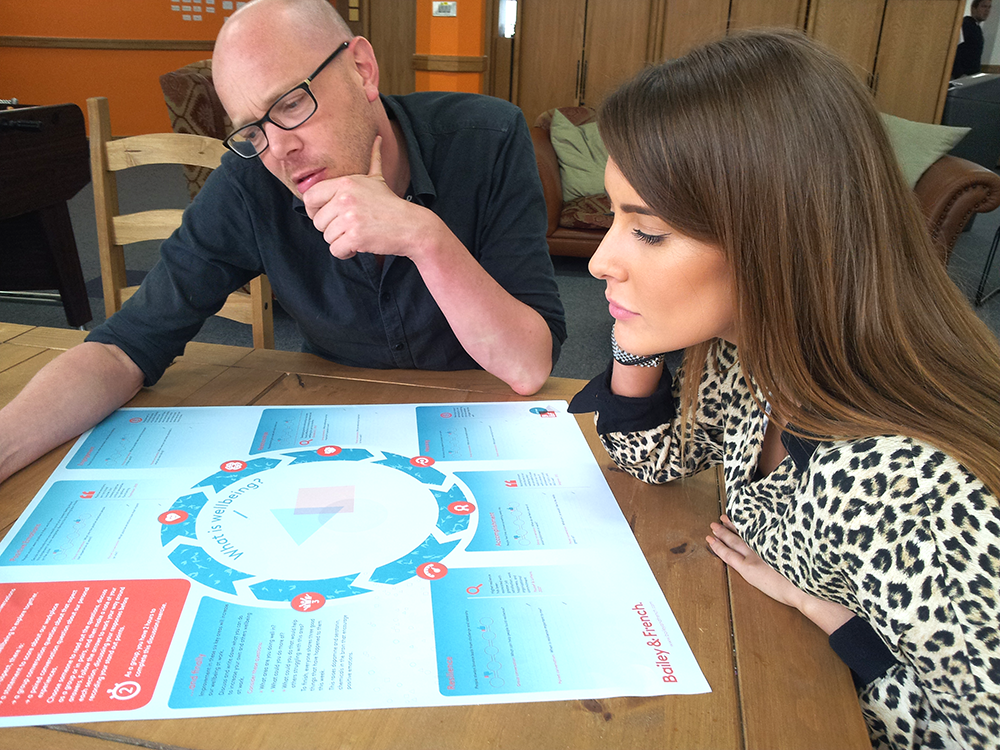
About Let’s
Wellbeing is talked about in organisations a lot, but there is often little on offer beyond physical health programmes and support for those with mental illness. Based on the latest research into wellbeing, this conversation mat helps us explore the five pillars of the ‘PERMA’ wellbeing model, building teams that are more aware of their own and others’ wellbeing, and what can affect it.
These self-facilitating, team discussion tools are designed to focus our attention on building wellbeing at work. Between 3-12 people use the tool to explore what helps us thrive and flourish at work, giving an immediate pulse check and diagnosis of the five pillars to support further action.
These are the ideal tools for small and large-scale team days, providing a simple and fun platform for engaging with individuals and teams. Easy to self-facilitate, each mat can be used by groups of up to 12 and multiple mats can be used in order to cover larger teams, groups or whole organisations. Each mat provides frame-worked discussion topics, encouraging each person to contribute, tackling difficult subjects in a non-judgemental way and empowering people to take action.
To purchase a wellbeing conversation mat simply click here. For more information on our wellbeing conversation mat or any of our other tools please contact info@baileyandfrench.com or call +44 1273 830 830.

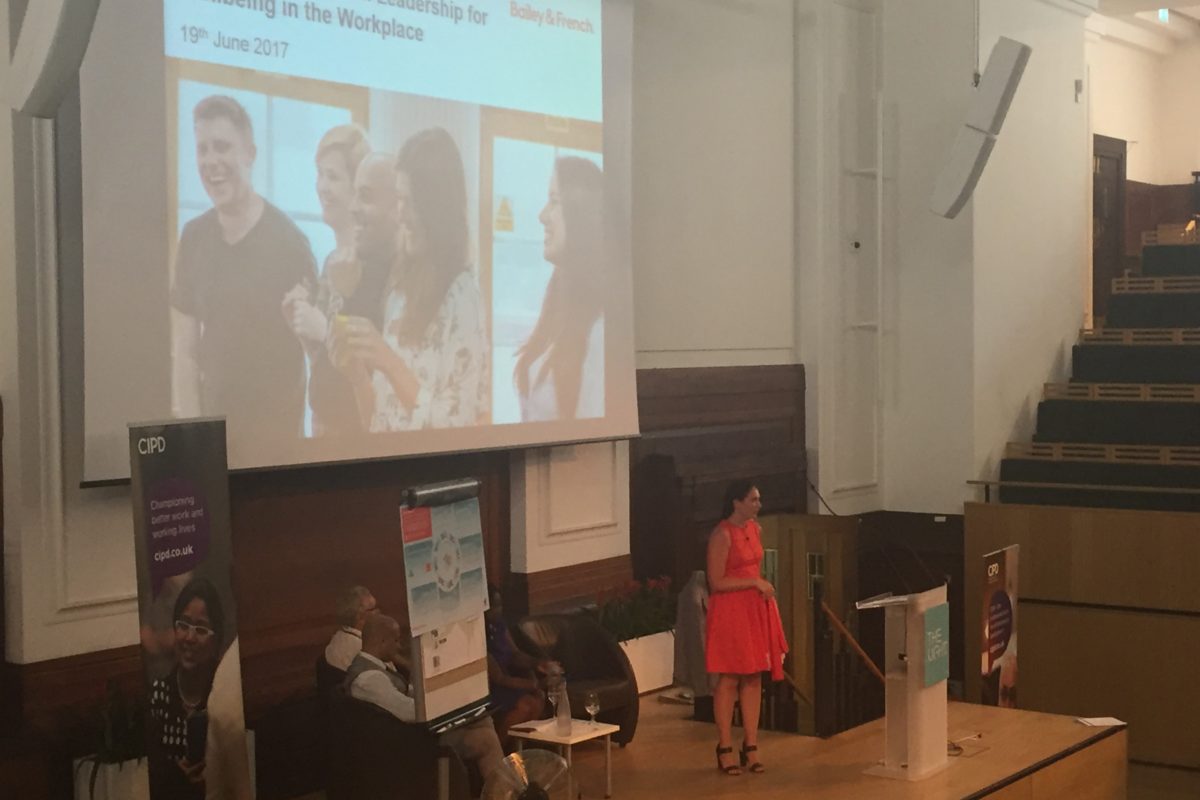
About Personal
We really enjoyed the CIPD Wellbeing conference in London on Monday and I was very happy to be able to share our preventative approach to Wellbeing focusing on the PERMA model of Flourishing and Thriving with those who attended.
We’ve since had some great feedback and so now sharing the video clip of our focused session for those who missed out on tickets as the event was sold out.
If you want to learn more about how we can support you to build a better organisation through Wellbeing, Strengths Based Leadership or Performance Motivation get in touch +44 (0)1273 830830, info@baileyandfrench.com, @baileyandfrench
Read our articles on the PERMA model + Resilience here and case studies of our work here.
Alex Bailey


About How
Early in my career, a question I was often asked by clients was ‘how can we build the resilience of our people?’. And if I’m honest, I didn’t truly know the answer.
I am exceptionally lucky and fortunate to work with lots of different people and organisations, across a range of industries and counties. Due to the context of work I do, people will openly share examples of the day-to-day stresses and challenges they face, both at work and personally, and how they deal with adversities and failures.
It’s true that there are some people who are by their very nature more tolerant to stress and ‘bounce back’ more easily. However, listening to these stories over many years, and drawing upon my own experiences, it became quite clear that resilience can be learned. Now the question I had to answer was ‘how?’.
My conclusion is that there is no exact formula or winning algorithm that clearly defines how to be more resilient. Rather, I see it as a combination of many things -‘one size does not fit all’ – with us drawing upon different resources depending on the challenges we face. Martin Seligman’s PERMA model gives us a great framework for these – in its own way, each element supports and enables more resilient behaviour. By building awareness and resources to support ‘Positive emotions’, ‘Engagement’, ‘positive Relationships’, ‘Meaning’ and ‘Achievement’ – and learning to maximise each element – we can ‘lead’ ourselves better through times of stress. And these elements work in conjunction with, and build upon each other too – positive emotions help us build relationships, which enable us to be more resilient, which in turn help us experience more positive emotions, and be more resilient, and so on.
As an example, let’s focus on positive emotions (the ‘P’ in ‘PERMA’). Knowing and understanding our emotions, and being aware of how we are feeling and why, means we can recognise when we are experiencing more negative than positive emotions. Negative emotions create a downward spiral that narrows our capacity to learn, problem solve and make decisions. So, making decisions when we are feeling down and despondent can diminish our ability to think creatively and find the right solution when we need it most. Further to this, an interesting piece of research I read recently showed how resilient individuals not only cultivate positive emotions in themselves, but they are also more skilled in eliciting positive emotions in others (Tugade et al., 2013). This in turn helps build a supportive network that aids the coping process.
One thing that is certain is that the world is ever-changing and in a constant state of ebb and flow as we all strive to maintain competitive advantage. Speaking with clients, this is very much a reality and a challenge in today’s modern working world. The consequence, however, is often stressed team members who are disengaged and unhappy. The context is unlikely to change in fact, it’s likely the world of work will become increasingly more dynamic. So, what’s the solution?
Current approaches often target the symptoms, for example offering Employee Assistance Programmes (EAP) or gym memberships. Yet this will not target the cause or solve the issue long-term. We need to be more strategic and preventative, empowering our people through their own and others’ learning and growth so we have the skills needed to be resilient. The world is dynamic and ever-changing, but by building our resilience we can enjoy the ride and be confident in knowing you have the self-awareness and personal resources to weather any storm.
Bailey & French are a team passionate about creating the simple, positive platforms and practical tools that support people to clarify what they truly want to achieve and then do it. We know everyone is busy at work so make sure our interventions are easy to apply, high impact and often self-facilitating. If you are interested in finding out more about how we work with individuals, teams and whole organisations to be more engaged, successful and positive, we’d love to hear from you.
This article on ‘Resilience’ is one of a sequence based on Martin Seligman’s PERMA model of wellbeing. Click on the following links for previous articles, on ‘Positive Emotions‘, ‘Engagement’, ‘Relationship’, ‘Meaning’ and ‘Achievement’.
Grace Walsh
References:
M. Tugade, B. L. Fredrickson and L.F. Barrett (2013). Psychological Resilience and Positive Emotional Granularity: Examining the Benefits of Positive Emotions and Coping and Health
Carver, C. S., & Scheier, M. F. (2002a). Optimism. In C. R. Snyder & S. J. Lopez (Eds.). Handbook of positive psychology (pp. 231-243). London: Oxford University Press.
Kumpfer, K. L. (1999). Factors and processes contributing to resilience: The resilience framework. In M. D. Glantz & J. L. Johnson (Eds.). Resilience and development: Positive life adaptations (pp. 179-222). New York: Kluwer Academic/Plenum Publishers
